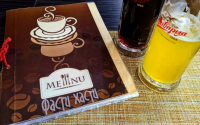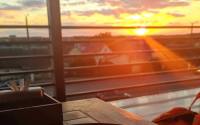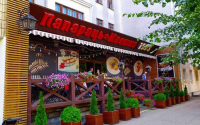Amidst the cacophony of US Presidential election campaigns, many Indian American youth are rallying for the Indian Prime Minister, Narendra Modi. Eager little dancers are fine-tuning their steps to be at their coordinated best when they perform for him on September 22 at the Nassau Coliseum in Long Island, New York. Thirteen-year-old Mahita Pendota is one of over 80 performers who will showcase their talent in traditional and popular pan-India performing arts. Beats of ‘Dhol baje' will reverberate across the venue as her group from East Coast's Shivaay Dance Academy will present ‘traditional garba in a Bollywood twist style' to a soundtrack custom-produced in India. Rohan Virdi, the co-founder of the academy, describes the enthusiasm among Indian American families thus: “They are willing to do anything possible to be a part of this show. Even if the parents will not get to attend, they don't want their kids to miss seeing Modiji.”
The enthusiasm among Indian American youngsters springs from the cultural milieu they are being raised in. For instance, Sandeep Shetty, a former Bollywood choreographer who runs New Jersey-based Rudra Dance Academy, not only focuses on technical skills but also ‘teaches culture'. “We educate them about cultural, current and historical things from India like festivals. Students know a lot about Modi. When they got to know the Prime Minister was coming to New York, they were so excited to participate!” he says. Shetty's group will also be presenting a Bollywood-style performance.
US-raised graduate Agrima Agnihotri finds herself fortunate to be one of the volunteers. She and many young second-generation immigrant peers who “speak highly of Modi” will be attending the event. “We finally get to see him!” she exclaims. Like her Indian immigrant parents, Agnihotri is convinced that PM Modi thinks “futuristically” and has “put India in a good light”. “Modiji is not only an inspiration in India. I like to think that he inspires us across the oceans. He is my role model personally. My parents are huge supporters, and I've learned to be a supporter as well,” she says. Calling him a "guiding light" for youth, she says Modi even makes Indian American youth feel cool about their identity and background socially. “After he became the PM, India is much more respected than earlier which makes us feel confident and validated when we talk to our non-Indian peers. The narrative has switched in our favour.”
Indian Americans Are A Diverse Lot
The largest Asian immigrant community in the US, Indian Americans are a diverse lot, representing various Indian cultures and political leanings. Their population has more than doubled in the last two decades. The ideological leanings of recent immigrants reflect home country politics, evident in their affinity for Indian political leaders. It is well-known that Modi is very popular among a large chunk of Hindu Americans. Temple University's Dr Sanjoy Chakravorty, co-author of The Other One Percent: Indians in America, is sceptical of generalising for most Indian Americans but recognises that the affinity for PM Modi among those from Gujarat is strong. “By and large, the second-generation children have very little political knowledge of India. In Gujarati families, there's a worship of Modi and you know how Gujaratis are well-represented in certain parts of the US, particularly in New Jersey, New York and Chicago.”
At the same time, for those growing up in the US, the dominant culture for a majority of Indian American youth remains American. “The American political horse race is kind of fascinating and it's constantly in your face. They constantly talk about it as it's always on TV, always in the news, and they get caught up in it. India is a distant thing and a good chunk of them have rarely been to India,” Dr Chakravorty explains. And thus, while some second-generation immigrants reject their parents' politics, there are others who follow it, he adds.
"A Bubble"
“You're seeing a particular bubble which I don't think is representative. It really doesn't strike me in any shape or fashion as something that's representative of the second-generation Indians in the US,” Chakravorty points out. Even so, within the bubble that's enthusiastic about Modi's visit, culture and politics seem to transcend continents and generations. The sign-ups for the event, dubbed as ‘Modi and US, Progress Together', crossed 29,700 according to a lead organiser. It was not open to the public and only well-recognised cultural and philanthropic US-based organisations could apply. The 600 selected, including sponsors, had to trim their member lists to be accommodated into the 13,500-capacity at the Nassau Coliseum.
Wanting to be seen and recognised, this is a grand stage for aspirational Indian diaspora members. “It's networking at the highest level. Being at a Prime Minister event is high visibility. Getting a picture taken with the Prime Minister is something they'll hang on the walls, show everywhere, put on their websites. It's not just Indians, everybody does it,” says Dr Chakravorty.
A group of US-based ‘Welcome Partner Organizations' have come together as the ‘Indo American Community of USA' to steer the effort. Participants will be taking long flights and drives from over 42 states to Long Island on the US East Coast. One of those attending from the West Coast is California-based Vijaya Aasuri, President of the Association of Indo-Americans, a conglomeration of 48 Indian cultural and charity organisations. She has been part of Modi's past meetings at The White House and diaspora events, including the 2014 Madison Square Garden summit and the 2019 Howdy Modi rally in Texas. Aasuri says she is looking forward to his latest address. “Every day, every minute you see growth in India. Getting those updates from the media is one thing but hearing about the progress directly from our honourable Prime Minister is very reassuring.”
Hindu Indian-Americans Biggest Supporters
In line with the religious demographics of the Indian American community, the rally will largely consist of Hindu Indian-Americans but will also have a smattering of other religions. Nikunj Trivedi, president of the Coalition of Hindus of North America, says, “I do know that there are Sikh groups, there's an Indian Christian group and a Muslim group. Ismaili Bohra Muslims from Gujarat maintain a strong affinity to the state. I know that as I am from Gujarat.” Meanwhile, two large Sikh-American groups as well as the Indian American Muslim Council say they will not be participating in the rally.
According to a lead organiser, the rally is being funded by participating groups and sponsors. One of the gold sponsors, Indiaspora, is an influential organisation whose mission is to “build bridges among diaspora leaders in several countries and professions with leaders residing in India”. They have close ties with US and Indian administrations and corporate leaders and are an example of the role the Indian diaspora plays in enhancing synergy between the two countries. Their Executive Director, Sanjeev Joshipura, says Indiaspora, a “secular and non-partisan organisation”, has been part of the Indian Prime Minister's earlier US visits too. “It makes sense for an organisation to work with the sitting Prime Minister of India regardless of political party. A lot of Indiaspora network and members are going to be part of the VIP seating and backstage opportunities with Foreign Minister Jaishankar, and a possible meet-and-greet with the PM.”
No Political Leanings
A clear directive being followed by the organisers is not to lean towards any one US political party. A few prominent Indian American politicians “might be” in attendance, but organisers say they will be at the event in their “personal capacity”. This would be unlike the 2019 ‘Howdy Modi' event, which saw addresses by both PM Modi and then US President Donald Trump. San Francisco Bay Area-based Democrat Ajay Bhutoria, member of ‘National Finance Committee 2024, Harris for President', is one of the attendants at the rally. He says, “During the planning stages, organisers had thought to extend invitations to both Trump and Harris, but they were unsure, just in case one accepts and the other doesn't for some reason. To avoid that, they decided against it, and are not inviting any members of Congress or elected officials.”
As preparations for the Long Island rally continue in full swing, Joshipura points out that though it is only natural that a mass rally would generate conversation and grab headlines, Modi's US visit will also be defined by several other non-public aspects. “There is the UNGA assembly going on, climate week is also at the same time, there is a QUAD meeting that will occur just before Modi's big speech in Nassau County and meetings with corporate leaders. In addition to what one sees on TV, there is a lot of substance to this visit, sometimes bilateral, in some cases even multilateral,” he says.
(Savita Patel is a San Francisco Bay Area-based journalist and producer. She reports on the Indian diaspora, India-US ties, geopolitics, technology, public health, and the environment. She tweets at @SsavitaPatel.)
Disclaimer: These are the personal opinions of the author







